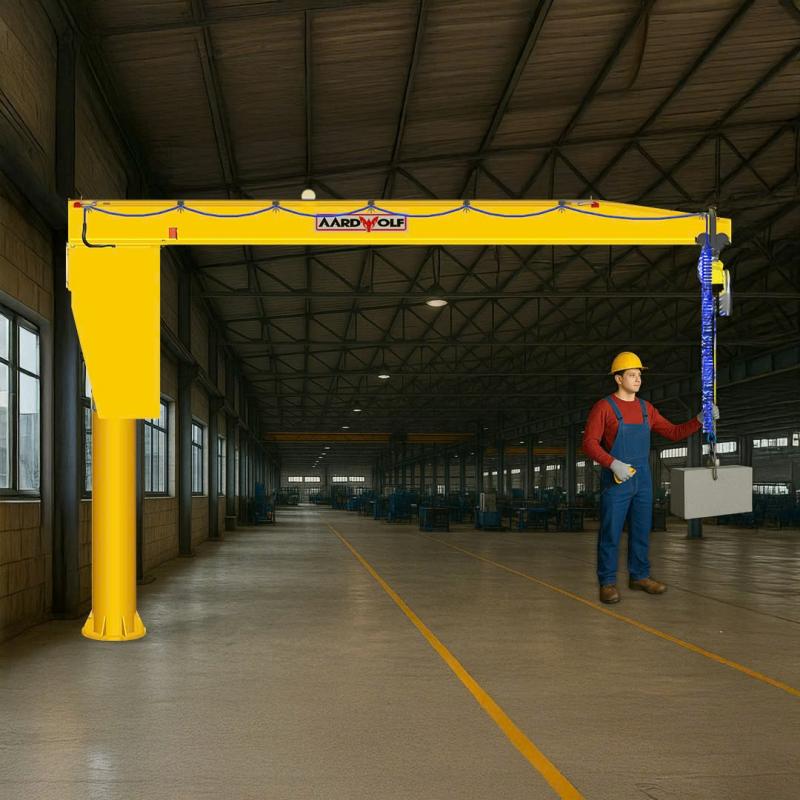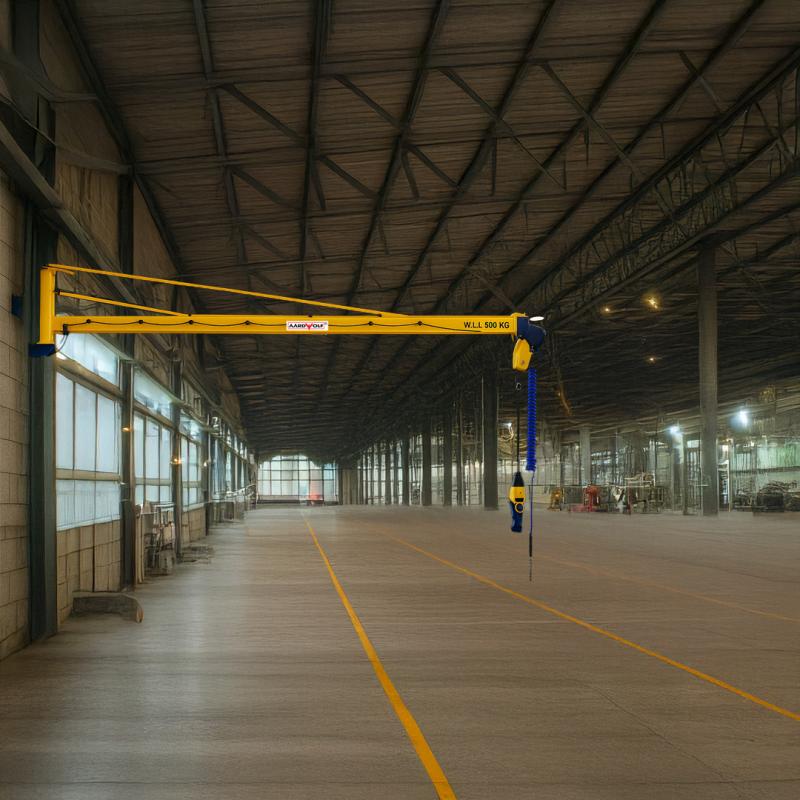



Efficient material handling is a major contributor to this goal—and jib cranes have become an indispensable solution. From moving raw materials to positioning finished components, jib cranes support critical operations across diverse manufacturing processes.
This article explores how jib cranes improve productivity, ensure safer workplaces, and provide tailored lifting solutions in manufacturing. Whether you operate a fabrication plant, assembly line, or precision engineering facility, implementing the right jib crane system can streamline workflows and enhance operational control.
To explore Aardwolf’s complete catalog of Jib Crane Products, including various mounting and lifting capacities, visit their official range.
Jib cranes are lifting devices designed for localized material handling. A typical system features a horizontal arm (jib or boom) mounted on a vertical support such as a wall, pillar, floor base, or ceiling. This arm supports a hoist that travels along its length and rotates to lift and move loads within a defined workspace.
Jib cranes are engineered for high-frequency lifting and placement of materials in a confined radius. Their space-saving design and fast cycle times make them ideal for workstations and production zones that require agility, safety, and repeatability.
Need help differentiating lifting systems? See: Difference between crane and jib cranes
Manufacturing facilities often involve the movement of materials between storage, production, and packaging zones. Jib cranes simplify these transitions by providing direct, on-demand lifting—minimizing time spent manually transporting heavy or bulky items.
Manual lifting is a common source of injury in manufacturing. Jib cranes enable operators to handle components ergonomically, reducing the physical strain associated with repetitive or awkward lifts.
By automating or assisting in the handling of parts and tools, jib cranes allow workers to focus on value-added tasks such as assembly, inspection, or welding—improving overall productivity.
Certain types like the wall mounted jib crane or ceiling-mounted models help free up valuable floor space, which can be reallocated for machinery, inventory, or walkways.
For a breakdown of how each crane type supports industrial needs, check: The role of a Jib Crane
A freestanding jib crane is mounted on a concrete base and provides 360° rotation. It’s ideal for central workstations or areas that require heavy lifting without relying on existing structural support.
Use in manufacturing:
The wall mounted jib crane is attached to an existing structural wall and offers 180° rotation. It’s ideal for compact production zones where space is limited but lifting precision is needed.
Use in manufacturing:
These cranes are installed on structural beams or trusses. They do not take up floor or wall space, making them ideal for facilities that need open floor layouts.
Use in manufacturing:
Pillar jib cranes, also known as column-mounted cranes, offer similar functionality to freestanding models but are attached to structural columns. They’re commonly found in heavy-duty manufacturing areas.
Use in manufacturing:
Articulating jib cranes feature dual pivot points, allowing the arm to bend and reach around obstructions. This flexibility makes them perfect for tight manufacturing cells or awkward lifting zones.
Use in manufacturing:
Jib cranes assist in lifting steel sheets, fabricated parts, or heavy tools to and from cutting, welding, or forming machines. Articulating and pillar-mounted cranes are especially popular due to their range and flexibility.
In delicate assembly lines, ceiling-mounted or articulating jib cranes help operators lift enclosures, racks, or sensitive components without contamination or manual handling.
From engine blocks to aluminum frames, automotive manufacturers rely on freestanding and pillar jib cranes for high-capacity lifting at multiple stations. Their smooth motion and reliability support precision work and cycle consistency.
Cleanroom-compatible ceiling mounted jib cranes are ideal for lifting equipment, packaging materials, or sanitary components in sterile production zones.
Choosing the right crane type and layout can make or break operational success. Before installing, consider the following:
For full details on installation and planning, follow this resource: How to apply a jib crane
| Benefit | Description |
|---|---|
| Reduced manual handling | Minimizes physical strain and lifting-related injuries |
| Faster workflow transitions | Speeds up movement of components and tools |
| Improved ergonomics | Operators perform tasks with minimal effort |
| Flexible integration | Available in multiple mounting styles to suit any layout |
| Increased throughput | Frees up staff to focus on production tasks, not load handling |
From increasing daily output to creating a safer workplace, jib cranes play a transformative role in modern manufacturing. Their ability to handle repetitive lifting tasks in confined or dynamic environments makes them ideal for assembly lines, fabrication shops, cleanrooms, and beyond.
Choosing the right type—whether it’s a freestanding, wall mounted, pillar, ceiling mounted, or articulating jib crane—can significantly improve manufacturing efficiency, reduce workplace injuries, and optimize use of space.
To explore full specifications, load capacities, and model recommendations, visit Aardwolf’s complete collection of Jib Crane Products.
References
1. How to operate a Jib Cranes safely
3. Over brace jib crane wall mounted
5. Is a Jib Crane a Gantry Crane
6. Articulated Jib Crane Wall Mounted
8. Manual Counterbalance Crane
10. Over Braced Jib Crane Column Mounted
Sign up to receive the latest info on new Aardwolf products, special offers and more.
By signing up you agree to receive emails from Aardwolf with news, special offers, promotions and other information. You can unsubscribe at any time.